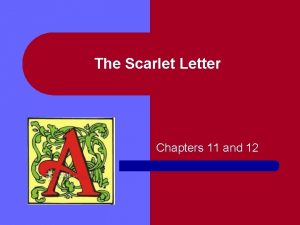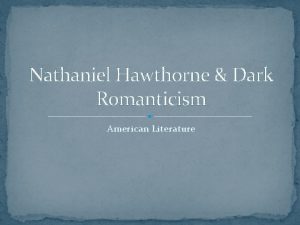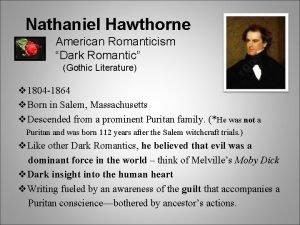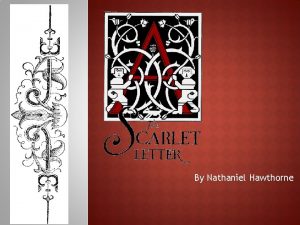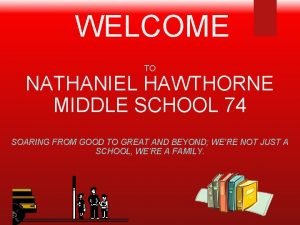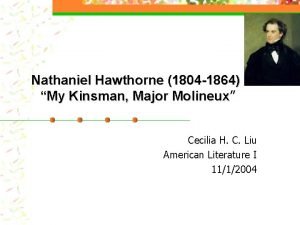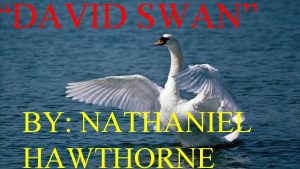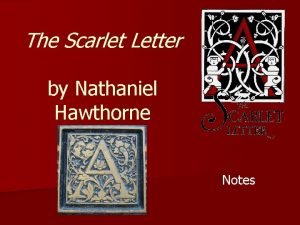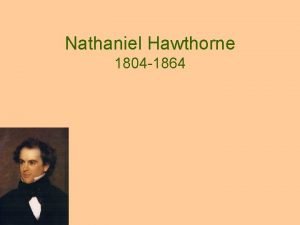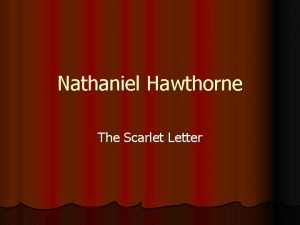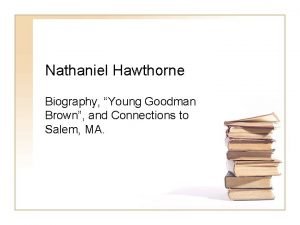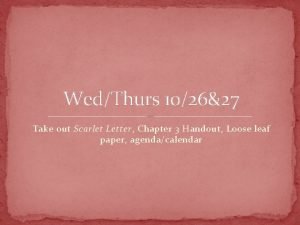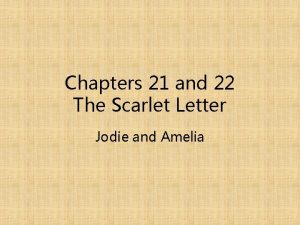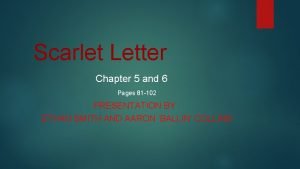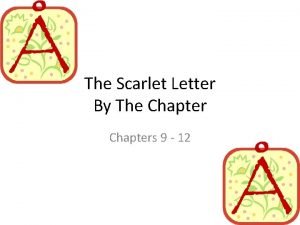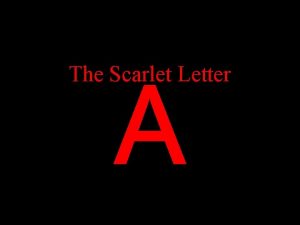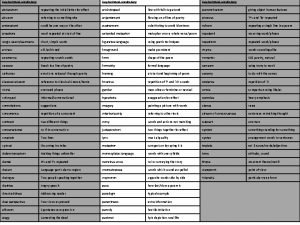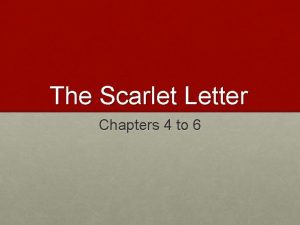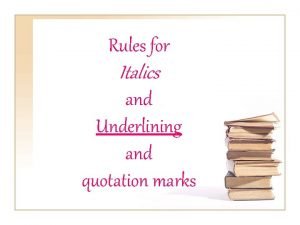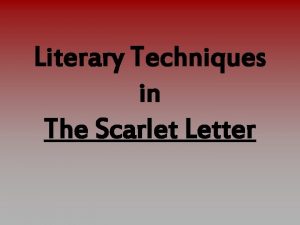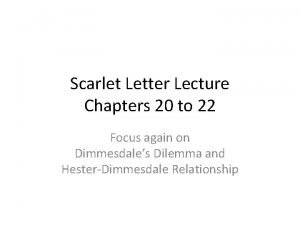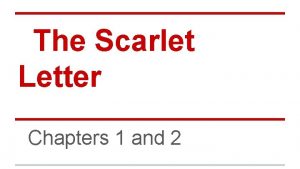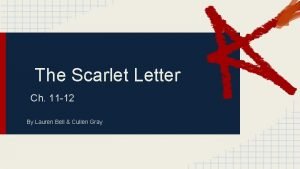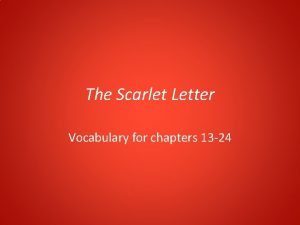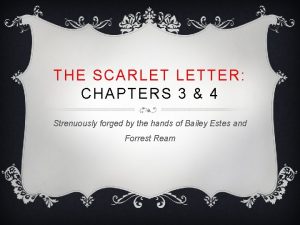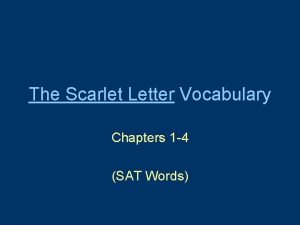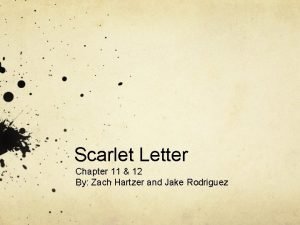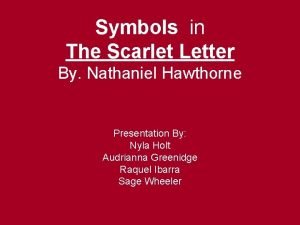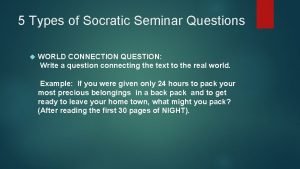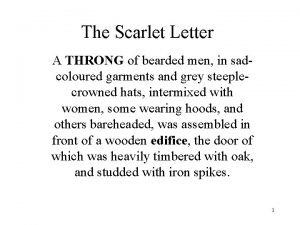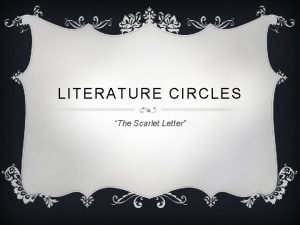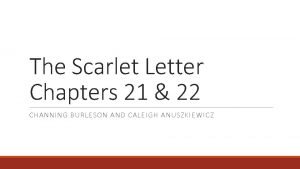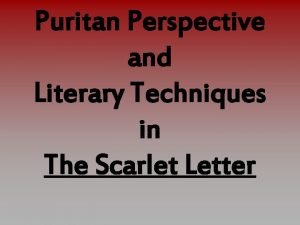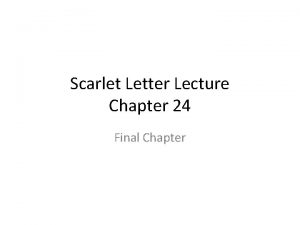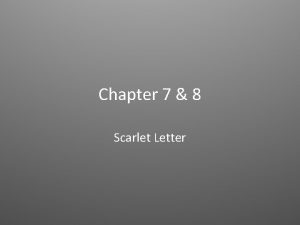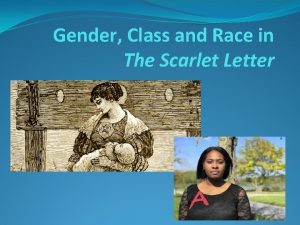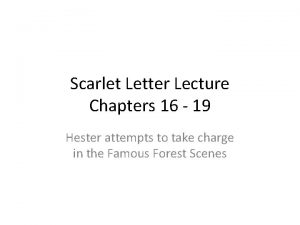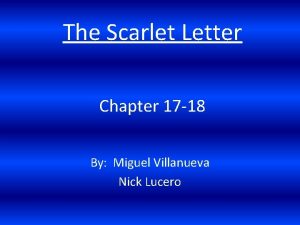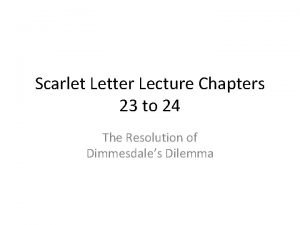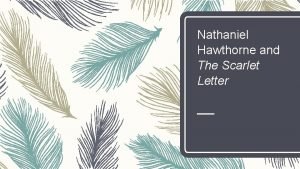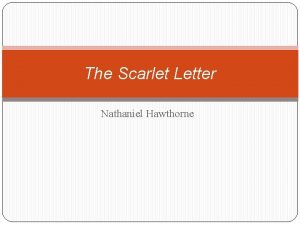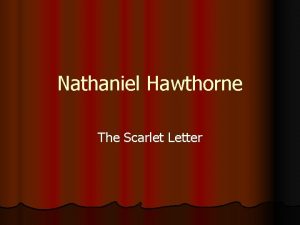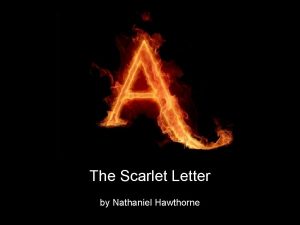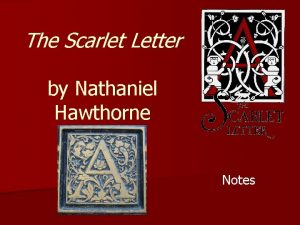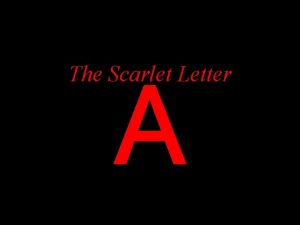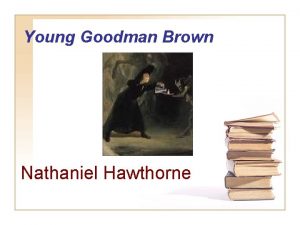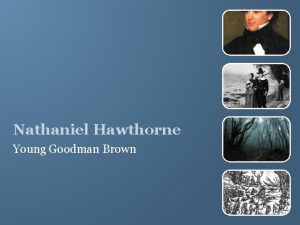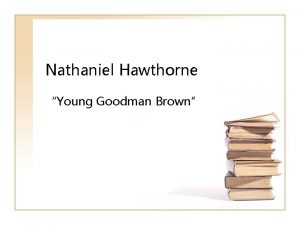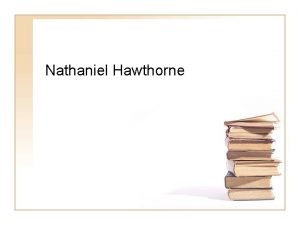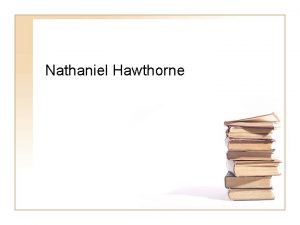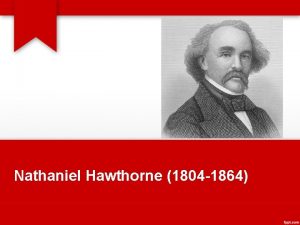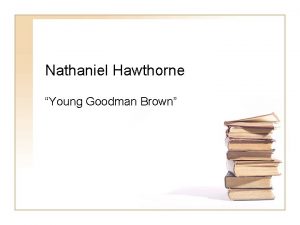The Scarlet Letter Nathaniel Hawthorne Who is Nathaniel










































![Quick discussion: • First impressions of Hester Prynne? o “It [the letter A] was Quick discussion: • First impressions of Hester Prynne? o “It [the letter A] was](https://slidetodoc.com/presentation_image_h2/92f9299645f60b2c5fc56baa466db37e/image-43.jpg)


- Slides: 45

The Scarlet Letter Nathaniel Hawthorne

Who is Nathaniel Hawthorne? • In your notebook, take notes on at least 3 things you find important about Nathaniel Hawthorne. • Nathaniel Hawthorne

Nathaniel Hawthorne • Important facts: o Hawthorne was born in Salem, MA. His name used to be spelled Hathorne, and his great-great grandfather was a judge during the Salem Witch Trials. o After graduating from college, Hawthorne wrote short stories. He needed additional employment, though, and friends helped him find a job at a custom house— a place in a port city where custom charges were collected. He lost his job there, and wrote about it in “The Custom House”—a prelude to The Scarlet Letter. o He was good friends with Herman Melville, author of Moby Dick—the book was dedicated to him. He enjoyed being alone more than being with people. o He is considered to be a father of American Literature.

The Scarlet Letter • Written between the time Hawthorne’s mother died in the fall of 1849 and February, 1850 • Considered to be a psychologically powerful take of the consequences of breaking a moral code—having an affair and getting pregnant during the 1600’s • Deals with the ideas of guilt and sin and how those ideas affect characters • Hester Prynne is considered by many as the first American heroine

Frame Narrative just a bit about the structure Not your typical novel structure… yet it is one you’re familiar with. The Painted Drum The Scarlet Letter Narrator = Faye Narrator = unnamed man The story of the drum’s origin (spanning decades prior to Faye’s life) in 21 st cent. New Hampshire Parts 1 & 4 of the novel The story of Hester Prynne (in Puritan Boston) in 19 th cent. Salem, MA The opening chapter, “The Custom House”

Reading Schedule • Chapters 1 & 2: Dec. 10 • Chapters 3 & 4: Dec. 12 • Chapters 21 -24: Dec. 18

The Custom House • Listen to the following video clip about The Custom House—the first part of The Scarlet Letter. • Answer the questions on the viewing guide sheet • An Introduction to The Scarlet Letter

The Custom House • Readers start off with a little direct address from the narrator. • This narrator is telling readers about his threeyear experience working in the Custom House (a building where people documented goods for import and export and paid taxes on the goods they received from other countries) in Salem, Massachusetts. • The Custom House has seen better days. It's mostly staffed by people who have job security because their families fund their positions.

The Custom House • Not many ships come to Salem anymore, so life is kind of slow for the narrator, who is the customs agent. • One day, he discovers a few documents and an odd scrap of fabric, an embroidered scarlet letter ‘A’. • These manuscripts bear the story of Hester Prynne as documented by a man named Jonathan Pue, who was collecting local history some hundred years before our narrator's time. • Our narrator decides to write out the narrative of Hester Prynne, but quickly realizes that his boring coworkers stifle his creative juices.

The Custom House • The narrator wonders whether his Puritan ancestors would scoff at him for wanting to do something as frivolous as writing a book to meditate on human nature. • And then, the Custom House gets a boss, and suddenly the narrator of the story loses his job. • In the end, losing his job is the best thing that could have happened because the narrator finds in this job loss the inspiration he needed to finish the story, overcoming some temporary writer’s block, and is finally able to tell the tale of Hester Prynne.

The Custom House • The narrator is not Hawthorne (the author)— he is a work of fiction. However, he shares much in common with Hawthorne. Both are Puritans, worked at Custom Houses, and both are tax collectors. • That said, know that this section of the text, “The Custom House, ” is set in the early 1800’s, but the story the narrator discovers (the bulk of The Scarlet Letter) and shares with readers is set in the mid-1600’s, whereas the Salem Witch Trials happened in 1692.

The Custom House • Remember, the Puritans felt that writing fiction was a waste of time. Any extra time should be spent worshiping God, helping others, or reading the Bible. Writing/reading fiction was thought to promote sacrilegious ideas and actions. • New Literary Term!!! o Romantic Irony: a technique that interrupts a story and reminds readers that what they are reading is only a story.

Chapters 1 & 2

Activity • On your own, brainstorm a list of major events from chapters 1 & 2. You should have at least 5 things that happened in your notebooks. • Now, share with your discussion group what you remember from chapters 1 & 2. After all members have shared, write down the 3 things you feel are the most important for these two chapters. Be ready to share out. • Discuss the reading guide questions for chapters 1 & 2.

Whole class—Chapters 1 and 2: • The author says that even an ideal community needs a cemetery and a prison. What does this statement imply? Do you agree? • The women of the town show less pity for Hester than the men. To what do you attribute this attitude? What does it say about Puritans? • What did the younger woman at the prison door say to the older women? What conclusions can we draw from this? • What is Hester’s first action in the novel and what does it reveal about her character? Describe her demeanor as she emerges from the prison.

Whole Class—Chapter 2 • How does Hawthorne characterize the Puritan women in paragraphs 2 -8? Consider his use of imagery, concrete details, diction, figurative language, and dialogue. Support your analysis with textual evidence. • How does Hawthorne evoke sympathy from the reader toward Hester Prynne in this chapter? Consider his use of imagery, concrete details, diction, and figurative language. Consider, too, his description of Hester (especially in contrast to that of the other Puritan women) and other details he provides about her. Use evidence from text to support your answer.

1. What is the setting of The Scarlet Letter? 2. What is the significance of the wild rosebush that grows beside the prison door? 3. What is Hester’s punishment? 4. What does the flashback reveal about Hester’s past? 5. Explain the significance of this quote: “Stretching forth the official staff in his left hand, he laid his right upon the shoulder of a young woman, whom he thus drew forward; until, on the threshold of the prison-door, she repelled him, by an action marked with natural dignity and force of character, an stepped into the open air, as if by her own force of will” (45).

Chapters 3 & 4

Chapters 3 & 4 • Describe the stranger standing next to the Indian during Hester’s punishment. What signal passes between him and Hester? What emotional affect does his presence have on Hester? • What argument does Dimmesdale use to try convince to Hester to name her “fellow-sinner”? How does Hester respond? How does her child respond? • Why does Hester say the scarlet letter can never be removed from her breast? • How does the sermon delivered by John Wilson begin to expand the symbolic significance of the scarlet letter? How does town gossip and superstition do the same? • What does Chilling worth mean when he says to Hester, “We have wronged each other”? • Why does Chillingworth ask Hester to keep his identity a secret? Why is this ironic?

First Impressions “Quiz” What do you think of the following characters? Use text evidence to support your ideas. • Hester Prynne • Roger Chillingworth • Arthur Dimmesdale • Read the passage that begins with “We have wronged each other. . . and ends with Sooner or later, he must needs be mine!” Then, give the speaker, what the speaker is saying, and the significance of the quote. Blue: 57 -58; Barnes: 63 -64; Orange: 86 -87

The End of the Book • What, if anything, surprised you about the ending? • What questions do you have regarding Hester, Pearl, Chillingworth, and Dimmesdale?

After the Book. . . Symbols and Motifs

Names & Places Hawthorne’s purposeful selection of character names & setting elements

What’s in a name? Brainstorm with your group: What is the significance/ figurative meaning of each of the following? Dimmesdale Chillingworth Pearl Be prepared to share your answers with the class. As your classmates share, make note of their ideas (as well as your own ideas) in the ‘notes’ section of your class notebook.


Significant Settings City life vs. natural world Once in your group, you’ll be assigned either the city of Puritan Boston or the New England coastline/ woods. With your group, explore the following: Who lives here? What key plot elements occur here? How do characters feel in this place? What trends do you see? Thomas C. Foster wrote in his book How to Read Literature Like a Professor that “geography in literature can also be more. It can be revelatory of virtually any element in the work. Theme? Sure. Symbol? No problem. Plot? Without a doubt. ”

Symbols/Motifs • • Night vs. Day The Scarlet Letter The Meteor Pearl The Scaffold The Prison Door/ The Rose bush The Black Man

Quotes • “But Hester Prynne, with a mind of native courage and activity, and for so long a period not merely estranged, but outlawed, from society, had habituated herself to such latitude of speculations as was altogether foreign to the clergyman. She had wandered, without rule or guidance, in a moral wilderness. . . The scarlet letter was her passport into regions where other women dared not tread. Shame, Despair, Solitude! These had been her teachers, --stern and wild ones, --and they had made her strong, but taught her much amiss. • “Mother, ” said Pearl, “was that the same minister that kissed me by the brook? ” “Hold thy peace, dear little Pearl!” whispered her mother. “We must not always talk in the marketplace of what happens to us in the forest. ”

Theme Discussion: The Scarlet Letter 2017

The 6 traits of theme statements • Theme should be expressible in the form of a statement with a subject and a predicate. • The theme should be stated as a generalization about life. Specific characters, locations and dates are unnecessary • Be careful not to make the generalization larger than is justified by the terms of the story • Theme is the central and unifying concept of a story. It must account for all major details of the story, not be contradicted by any details in the story, and cannot rely upon supposed facts. • There is no ONE way of stating theme of a story. • Avoid any statement that reduces theme to some familiar saying or cliché that we have heard all of our lives such as “You can’t judge a book by its cover” or “love is blind. ”

Possible Themes of The Scarlet Letter? • Think about the following ideas to get started: o Sin o Revenge o forgiveness o Hypocrisy o Justice o Isolation • How do these ideas relate to the novel?

How can you identify a theme? ? v Think about patterns in character behavior or thoughts. v Pay attention to relationships between characters. v Look foreshadowing clues that led to plot development. v Think about an implied lesson or moral you found in the story.

Let’s Do This! • In groups, choose two of the big ideas listed below: o o o Sin Revenge Hypocrisy Justice Isolation • For each one, think of at least 2 events that happened in the novel that would prove that idea. Write those down. • Share your ideas with the class.

Next steps • Now, think of the lesson that is illustrated with the events your group found. • Write that lesson in a complete sentence. o It’s important to forgive and forget. • No clichés o Things happen when you forgive someone. • No you, what things? o Forgiveness is the key to happiness and contentment.

Now, choose one theme statement. • Go back through the text and find at least 2 examples that would support that theme statement. o Write the examples down—be sure to include the page numbers. • Share your group’s theme statement and evidence with the class.

Quiz/Twiz

Questions chapters 20 -23 1. Upon leaving the forest Dimmesdale meets (a number) people from his congregation who tempt him in one way or another. 2. Hester is afraid that will call out to Dimmesdale during the procession. 3. In the final chapters Pearl is wearing a bright . 4. Which characters have secured a passage on the ship by the end of chapter 22, “The Procession”? 5. In chapter 23, “The Revelation of the Scarlet Letter”, the minister asks for the forgiveness of (a possessive proper noun / pronoun) sin while standing upon the scaffold.

Questions chapter 24 & the novel as a whole 6. Do readers ever actually learn how the ‘A’ became fixed onto Dimmesdale’s chest? (yes or no) 7. In old age Hester creates clothing that is: a) b) c) d) e) f) Very Puritan-like in color and style Very non-Puritan-like in color and style Sized for babies/children (possibly Pearl’s babies/children? ) Both A & C Both B & C None of the above: Hester quits sewing after Pearl dies 8. When Chillingworth dies/vanishes he leaves Pearl his will. 9. (name[s]) _____ in is/are buried in the cemetery near the prison door… 10. … and his/her/their simple grave-marker reads . (directly quote it)

Discussion Questions • The wearing of the scarlet letter was intended to isolate Hester Prynne from society and to call attention to her sin. Given the way in which Hester’s life ends, do you think that the scarlet letter accomplished what the magistrates intended? Explain. • In your opinion, what effect does Pearl have on Dimmesdale? What role, if any, does she play in bringing about his confession? Explain your answer.

In-Class Essay • On a piece of lined paper, respond to 2 of the following statements. The topic sentence should give the statement and what you are doing with it. In each paragraph, explain how the statement pertains to The Scarlet Letter. Be sure to use the text for support/evidence. Remember the 12 -sentence format!! • Defend, Refute. or Modify: Seeking revenge is a worse crime than adultery is. It is absolutely wrong to lie and deceive. Society shuns people for certain actions. Sins of passion are acceptable. Sins of principle are not.

In-Class Essay • On a piece of lined paper, respond to 2 of the following statements. The topic sentence should give the statement and what you are doing with it. In each paragraph, explain how the statement pertains to The Scarlet Letter. Be sure to use the text for support/evidence. Remember the 12 -sentence format!! • Defend, Refute. or Modify: Seeking revenge is a worse crime than adultery is. It is absolutely wrong to lie and deceive. Society shuns people for certain actions. Sins of passion are acceptable. Sins of principle are not.

Kahoot! • Directions: o Take out your phone or other technological device. o In the browser, type in kahoot. it o When the screen prompts you, type in 5062899 o Create a name for you and your partner that is appropriate for school. o Good Luck!
![Quick discussion First impressions of Hester Prynne o It the letter A was Quick discussion: • First impressions of Hester Prynne? o “It [the letter A] was](https://slidetodoc.com/presentation_image_h2/92f9299645f60b2c5fc56baa466db37e/image-43.jpg)
Quick discussion: • First impressions of Hester Prynne? o “It [the letter A] was so artistically done…which was of a splendor in accordance with the taste of the age, but greatly beyond what was allowed by the sumptuary regulations of the colony. ” o “with a burning blush and yet a haughty smile” o “as if her heart had been flung into the street for them all to spurn and trample upon”

Activity: • Create groups of 4 with the people near you. In your notebook, write: • Who • What • Where • When • Why • Leave space for answers

With your group: • Answer the 5 “W”s with regard to chapters 3 & 4 of the novel. • Everyone stand up. • Tallest person in the group move to another group (go clockwise) and share your group’s answers. • While listening, the rest of you will add to your notes and point out any incorrect or missing information. • Everyone stand up. • Tallest person select someone to move counterclockwise to the next group. Repeat. Go back to your original group – discuss changes
 The scarlet letter chapter 11
The scarlet letter chapter 11 American romanticism nathaniel hawthorne
American romanticism nathaniel hawthorne Allegory young goodman brown
Allegory young goodman brown Nathaniel hawthorne puritan background
Nathaniel hawthorne puritan background Dark romanticism in young goodman brown
Dark romanticism in young goodman brown Nathaniel hawthorne presentation
Nathaniel hawthorne presentation Ms 74 website
Ms 74 website Nathaniel hawthorne my kinsman major molineux
Nathaniel hawthorne my kinsman major molineux David swan setting
David swan setting Nathaniel hawthorne
Nathaniel hawthorne The birthmark foreshadowing
The birthmark foreshadowing Nathaniel hawthorne literary period
Nathaniel hawthorne literary period Scarlet letter timeline
Scarlet letter timeline Nathaniel hawthorne puritan background
Nathaniel hawthorne puritan background Nathaniel hawthorne background
Nathaniel hawthorne background Grass letters
Grass letters The scarlet letter chapter 3
The scarlet letter chapter 3 Scarlet letter chapter 22 summary
Scarlet letter chapter 22 summary The scarlet letter summary chapter 5
The scarlet letter summary chapter 5 The scarlet letter video
The scarlet letter video The scarlet letter chapter 9 summary
The scarlet letter chapter 9 summary Scarlet letter prison door
Scarlet letter prison door Adam warlock alliteration
Adam warlock alliteration The scarlet letter chapter 4
The scarlet letter chapter 4 Italicize or quote short story titles
Italicize or quote short story titles Scarlet letter chapter 19
Scarlet letter chapter 19 The scarlet letter essay topics
The scarlet letter essay topics The scarlet letter chapter 20 summary
The scarlet letter chapter 20 summary The scarlet letter chapter 1 summary
The scarlet letter chapter 1 summary The scarlet letter chapter 11 summary
The scarlet letter chapter 11 summary Scarlet letter vocabulary
Scarlet letter vocabulary Scarlet letter chapter 4-5 summary
Scarlet letter chapter 4-5 summary The scarlet letter vocabulary chapters 1-4
The scarlet letter vocabulary chapters 1-4 Scarlet letter 11-12
Scarlet letter 11-12 Rose bush quote scarlet letter
Rose bush quote scarlet letter Seminar questions examples
Seminar questions examples Snl scarlet letter
Snl scarlet letter Scarlet letter essential questions
Scarlet letter essential questions Chapter 22 scarlet letter
Chapter 22 scarlet letter Literary techniques in the scarlet letter
Literary techniques in the scarlet letter Chapter 24 scarlet letter
Chapter 24 scarlet letter Chapter 7 scarlet letter
Chapter 7 scarlet letter Scarlet letter race
Scarlet letter race The scarlet letter chapter 16
The scarlet letter chapter 16 Scarlet letter 17-18
Scarlet letter 17-18 The scarlet letter chapter 23
The scarlet letter chapter 23
